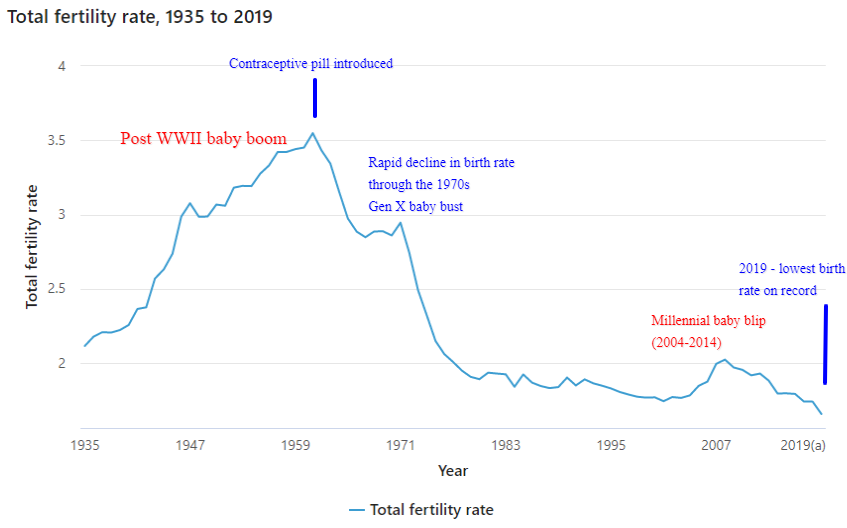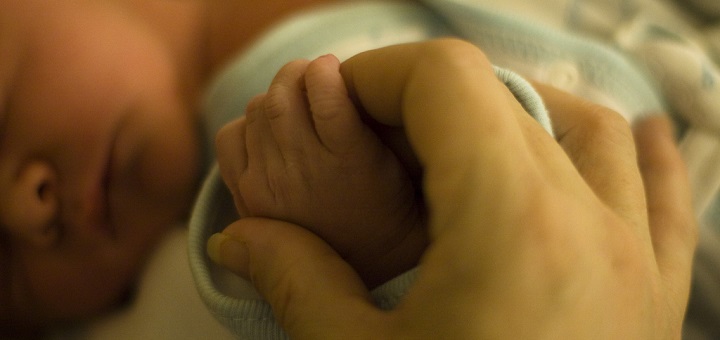The increase in the Australian birth rate since 2002 is well documented, and was largely unexpected, as most of us expected the trend towards smaller families and more childless couples to continue for the foreseeable future, as has happened in places like Italy and Japan, which have rapidly ageing populations.
There are probably a number of reasons for the upswing, but the most common suggestion we hear from our clients is that it has to do with the introduction of the “baby bonus”, causing many younger people to have children for financial reward. While it is possible that some people may be doing this, the evidence shows it is clearly not a major impact on the birth rate.

Picture: David Caird Herald Sun

The “baby bonus” was a federal tax rebate scheme for first time mothers introduced in 2002, which was expanded in 2004. It is a lump sum payment directly to the mother, starting at $4,000 per child and rising to $5,000 (and indexed to CPI annually) from 2008.
In 2004 the then treasurer, Peter Costello, exhorted couples to have “one for mum, one for dad, and one for the country” to try to increase the birth rate. With all due respect to Mr. Costello, we don’t think a lot of people actually listened to what he said (would you really have a baby because a politician said so?) The upswing in fertility was already underway by the time he made these comments, and was most likely due to some demographic shifts, though the data wasn’t out to show it at the time.
If the baby bonus was primarily responsible for the birth rate increase, it would likely have the effect of increasing fertility rates among younger mothers, for a higher proportion of which $4-$5,000 would represent a lot of money. To established career-women, it’s less likely to be a major incentive, and if you’re already a dual income couple with a mortgage looking to start a family, it might be a nice bit of extra income but isn’t going to be the deciding factor as to whether or not you can afford to have children (in fact it’s unlikely to be the deciding factor for all that many younger women either).
In fact what we see is the opposite. Figure 1, below, is straight from the ABS publication, Births, Australia, 2009, and shows the total fertility rate over 70 years. The post-WWII baby boom is very evident, when the birth rate rose to about 3.5, as is the decline after the introduction of the contraceptive pill in 1961. The lowest over all fertility rate of 1.73 was recorded in 2001, then it rose to 1.97 in 2008, before dropping slightly in 2009. The last year in which total fertility was at a similar rate to 2009 was in 1977.

Source: ABS, Births, Australia, 2009 (3301.0)
The next chart shows the age breakdown of that fertility rate, by age of mother. In 1977, the peak age for a woman to have children was 25. In 2001, at the low point of the national fertility rate, it was 29, while by 2008, after the upswing in fertility rate, it was 31.
The graph shows the very large drop in fertility among younger women from 1975 to 2001, and this didn’t increase from 2001-2008. You may be able to argue perhaps that the baby bonus stopped it from falling any further, and it appears to have stabilised. It is actually older women who are leading the charge in having more children. In particular, since 1975, fertility rates among women in their late 30s and early 40s have more than doubled.

So what seems to have happened is that the fertility rate fell as a generation of women delayed having children much longer than their parents did. This is likely to do with larger numbers of women wanting to have careers, and increases in housing costs meaning that most couples need two incomes to pay the mortgage, so women need to work longer. These women started having their delayed children in the early 2000s and hence the fertility rate began to rise again. Those in the next generation were not delaying having them any longer than they did in 2001 so that lag has worked its way through the population.
The increases in fertility among older women since 1977 are also partly to do with improvements in medical technology such as IVF and other forms of assisted fertility. You can see that “childbearing age” is now spread out over a longer time in a woman’s life than it was 30 years previously.
So the recent baby boom may be little more than the actions of this one cohort of women (themselves the children of the baby boomers) delaying childbirth. As this cohort moves through the population, you get the upswing we’ve seen recently.
The evidence suggests Peter Costello may not be able to claim as much credit for it as he hopes.
A good test of this theory will be to see if the most recent change to financial support for parents has an effect. The Paid Parental Leave scheme introduced in January 2011 provides government income support for mothers/primary carers who were in employment prior to the birth, allowing up to 18 weeks leave for new parents.
My prediction is that it will have little or no effect on the fertility rate. The rate is now likely to stablise and decline slightly again (though perhaps not as low as in 2001), as the effect of the “delayed cohort” of new mothers move through.
However, the impact of the children born in this most recent baby boom will have an impact on the population for many years to come.
If you enjoyed this article, sign up to get updates via email or twitter (above), and feel free to share it.













